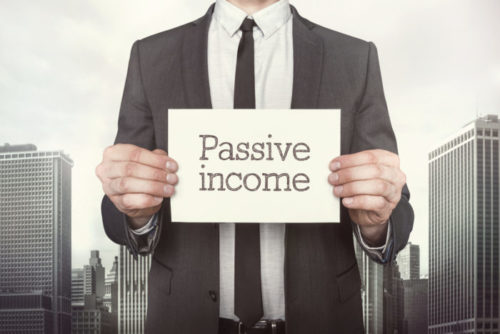Passive income is income that is generated with minimal effort on the part of the recipient.
This doesn’t necessarily mean no work is involved. In fact, maintaining streams of passive income often requires significant management and oversight. Nevertheless, passive income is still distinctly different from regular income, which consists of investing a set amount of time or effort in order to receive a paycheck.
On the one hand, regular income is characterized by its limited nature. Once you’ve done the work and been paid for it, the transaction is complete. On the other hand, passive income continues to be generated for you, whether you’re working or not. It’s this very nature that has led to the common aphorism that passive income involves “making money, even while you sleep.”
Table of Contents
How to Get Passive Income in Retirement
While passive income is a nice thing to have at any time of life, it is particularly useful for those who are in retirement. The ability to have a dependable source of income that isn’t significantly impacted by the amount of work you put in on a daily basis is critical to the very tenets of the retired lifestyle.
If you’re looking for ways to build a passive income throughout your retirement, there are several different options available, including:
- Dividend stocks;
- Lack of material participation in a business;
- Peer-to-peer lending;
- Property;
- Self-charged interest.
These are all effective ways to generate passive income in retirement, and they are broken down in further detail below.
Common Passive Income Mistakes
While all of the sources of passive income previously listed have their benefits, they should also be approached with care. Blindly pouring time, effort, and resources into building up sources of passive income is reckless and potentially harmful to your long-term financial health.
Here are a few common passive income misconceptions to guard against as you go about allocating your funds and planning for your retirement income:
- Passive income means no work: While the money made from passive income is not directly connected to the number of hours you work, many passive income options still require a significant amount of effort, attention, and even hands-on management, all of which should be planned for.
- Passive income responsibilities can be easily passed off to others: It’s tempting to think you can simply hire a broker or a property manager to oversee your passive income assets, and that is certainly an option. However, while it does reduce your workload, it doesn’t mean you can ignore your passive income streams completely. Direct, hands-on management from time to time is always required if sources of passive income are to remain healthy over the long term.
- You can successfully manage your passive income alone: Particularly when considering passive income for retirement, it’s important to avoid managing all of your sources of income alone. As you age, you may become less physically and mentally capable of handling decision-making properly, and when this happens it’s important to have a trusted family member or confidant who can help you manage your portfolio.
While passive income is a powerful retirement tool, it should never be approached as a magic bullet for your retirement that requires no effort or attention.
Types of Passive Income
Below are the basic definitions for each type of passive income that can be particularly effective when preparing for retirement:
Dividend Stocks
Putting money into the stock market is a classic form of retirement investing for many seekers of passive income. However, if you’re looking for a way to generate passive income immediately while still saving for the future, you may want to consider looking for dividend stocks, in particular.
Dividend stocks possess the potential to appreciate in value, but also pay dividends to stock owners on a regular basis, either in the form of cash or additional stock. At times these dividends can be significant, paying out as much as 5% or more of the value of the stock itself. This can provide a steady stream of side income while you wait for your assets to appreciate.
Lack of Material Participation In a Business
If you aren’t interested in the work of starting your own business, you can still invest in a fledgling company as a silent partner. In this case, the responsibility of running the company remains on the original business owner, while you simply provide the capital necessary for the small business to expand.
This allows you to invest in the ownership of a growing business without requiring the time and effort to start the business yourself.
Peer-to-Peer Lending
One way to generate passive income with your existing retirement savings is to use it to literally generate interest by functioning as a bank. Peer-to-peer lending consists of loaning your money to others like yourself in order to have it paid back with interest.
You can use a number of different peer-to-peer apps such as Upstart and Lending Club. While the risk is high, so is the reward, as this form of lending typically comes with higher-than-normal interest rates.
Property
One of the classic forms of passive income consists of investing in real estate. Owning property is an excellent way to diversify your retirement savings and can open up the door to a simple form of passive income — renting.
Whether you’re renting an Airbnb or an entire apartment complex, owning property can be a lucrative investment. However, this option may also quickly become the most labor-intensive. While you can always hire a property manager to siphon some of the responsibilities away from yourself, remember that this will eat into your passive income. In addition, the sizable initial upfront investment required to purchase property makes it a passive income option that should be selected with care.
Self-Charged Interest
Finally, if you own or partly own a business, you can make a nifty stream of passive income by literally loaning money to your company, an activity that naturally generates self-charged interest.
If you have a lump sum of cash that you can invest in your company, you can do so as a business loan. Then, as your company slowly pays you back for the loan, they do so with interest, which creates a stream of extra income that you can count on, regardless of the ups and downs of the business itself.
While self-charged interest is simplistic in theory, it’s worth noting that in practice it can be a bit complex. For instance, you must claim this income as a deductible self-charged interest expense on your taxes, and the income is only considered passive if you do not have an active management role in the company.
In general, if you’re going to utilize a self-charged interest approach to passive income, it’s wise to consult a certified public accountant as you set things up.
Image Source: https://depositphotos.com/





